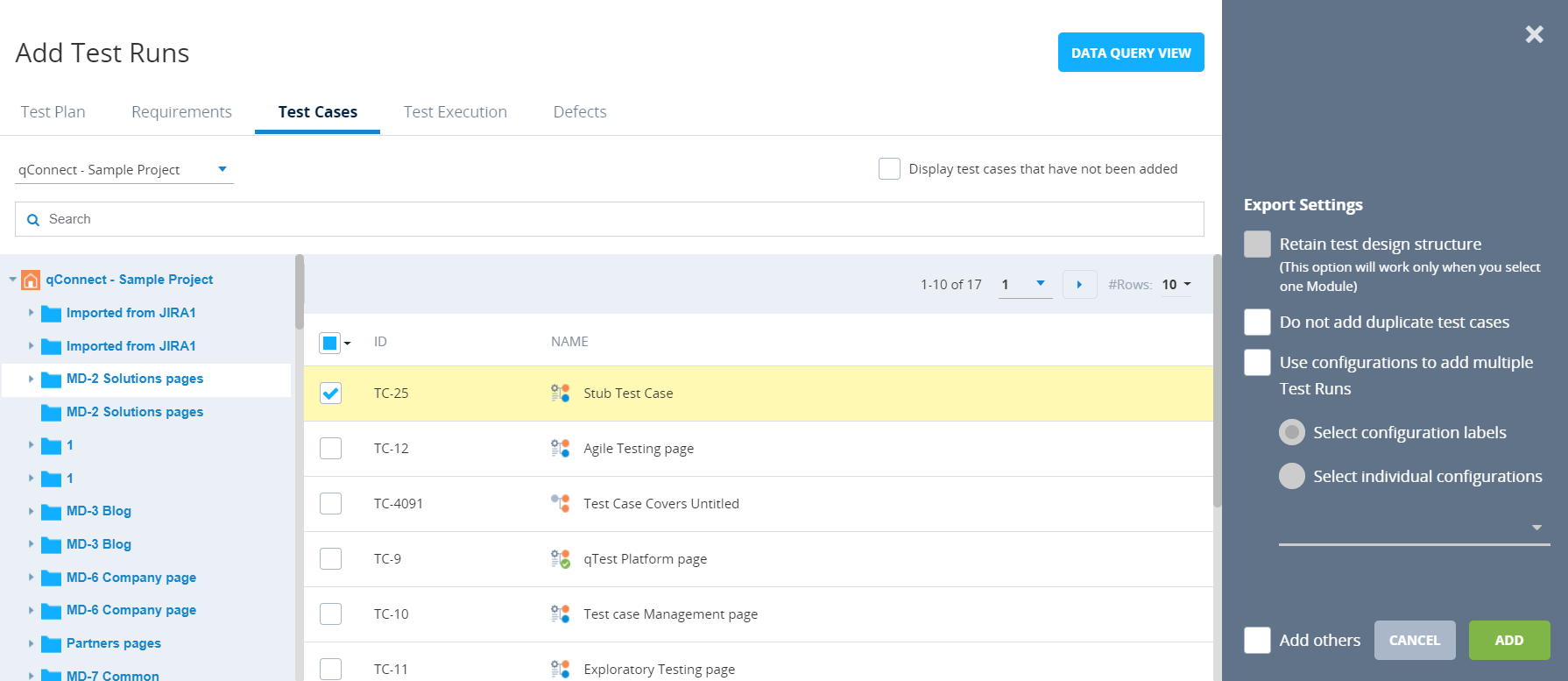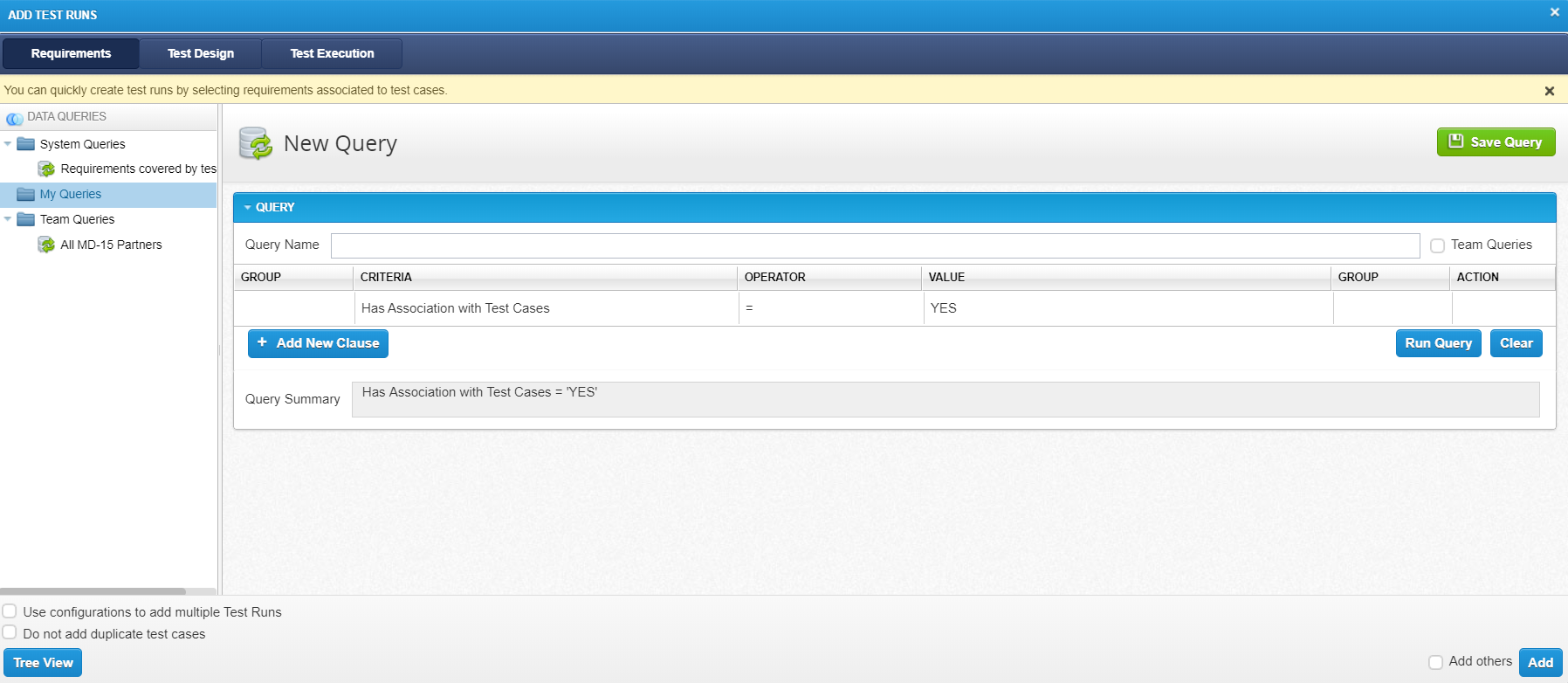Add Test Runs Dialog
The Add Test Runs dialog is used to manually add Test Runs to a qTest Manager Project. The Add Test Runs dialog can be used in either Tree view or Data Query view, based on your preference.

Access the Add Test Runs dialog
-
Click the Test Execution tab.
-
In the tree panel, select an object to add Test Runs to, such as a Test Cycle or a Test Suite.
-
Click the Add Test Runs icon
 in the toolbar.
in the toolbar.The Add Test Runs dialog appears.
Tree view

To access Tree view, click Tree View when in Data Query view. In Tree view, the Add Test Runs dialog is divided into separate tabs, allowing you to easily add Test Runs based on a variety of test objects. Objects on the Test Plan, Requirements, Test Cases, and Test Execution tabs are listed in a tree panel on the left side of the dialog. Child objects of objects selected in the tree panel then display in the grid in the middle of the dialog. For example, on the Test Plan tab, select a Release in the tree panel to display Builds and Requirements associated with the Release in the grid.
When you select objects on the Add Test Runs dialog, selections are retained even when you switch tabs, allowing you to export objects from different tabs. For example, you can select five Requirements on the Test Plan tab and then select three Test Cases on the Test Cases tab. When you click Add on the Test Cases tab, new Test Runs will be created for all eight selected objects.
The following tabs are available in Tree view.
| Tab | Description |
|---|---|
| Test Plan | Select test plan objects to add Test Runs for, such as Releases or Builds. |
| Requirements | Select Modules to add Test Runs for. You can also use the Search field to quickly search for Modules by ID or name. |
| Test Cases |
Select Modules or Test Cases to add Test Runs for. You can use the unlabeled Project field to select a different project to view Test Cases for, which can be useful if you are sharing Test Cases with another Project. For a procedure on using the Project field to add Test Runs using Test Cases from another Project, refer to Add Test Runs Using Test Cases from Another Project. In addition, you can select the Display test cases that have not been added check box to refresh the grid and display only Test Cases that have not already been added to the current Project. You can also use the Search field to quickly search for Modules or Test Cases by ID or name. |
| Test Execution | Select Modules to add Test Runs for. You can also use the Search field to quickly search for Modules by ID or name. |
| Defects |
Select Defects to add Test Runs for. You can use the Search field to quickly search for Defects by ID or summary. If an external system is enabled, you can choose whether to display external and internal Defects or internal Defects only by selecting the Display internal defects only check box. Internal Defects display with an icon in the Status column, indicating the status of the Defect. External Defects do not display an entry in the Status column. Click Fetch to fetch the most recent Defect data from your external Defect tracking system and refresh the Defects grid to display new information. For a procedure on adding Test Runs based on Defects, refer to Add Test Runs Based on Linked Defects. |
Data Query view

To access Data Query view, click Data Query View when in Tree view. In Data Query view, you can search for and select objects using the Data Query feature. For more information on creating and running data queries, refer to Data Query. For a procedure on adding Test Runs using data queries, refer to Add Test Runs Using Data Query.
The following tabs are available in Data Query view.
| Tab | Description |
|---|---|
| Requirements | Run queries for Requirements, such as queries displaying unassigned Requirements. |
| Test Design | Run queries for Test Cases, such as queries displaying all approved Test Cases or Test Cases that do not have Test Steps. |
| Test Execution | Run queries for Test Runs, such as queries displaying unassigned Test Runs or Test Runs that are not associated with Requirements. |
Export settings
Various export settings are available on the Add Test Runs dialog in both Tree view and Data Query view. These settings include options for adding Test Runs, such as whether to exclude duplicate Test Cases and whether to keep the Add Test Run dialog open after adding Test Runs.
The following export options are available.
| Option | Description |
|---|---|
| Retain test design structure |
When managing Test Runs on the Test Execution tab, it can be beneficial to organize Test Runs in the same structure used on the Test Design tab. Select the Retain test design structure check box to mirror the folder structure from the Test Design tab when adding Test Runs on the Add Test Runs dialog. Folders on the Test Design tab that contain subfolders will be created as Test Cycles on the Test Execution tab. Folders that do not contain subfolders are created as Test Suites. This option only displays on the Test Cases tab in Tree view. In addition, this option can only be used when one Module is selected.
Known issue: Intermittently, Test Cycles and Test Suites are created in reverse order when the Retain test design structure check box is selected. Currently, Test Cycles and Test Suites must be manually reordered after creating Test Runs.
|
| Do not add duplicate test cases |
Select the Do not add duplicate test cases check box to indicate that Test Runs should only be added to the current project. This option is useful when adding Test Runs from Test Cases that are shared with another Project. If this check box is not selected, and Test Runs are added from shared Test Cases, Test Runs will be added to both the current Project and the Project that the Test Cases are shared from. |
| Use configurations to add multiple Test Runs | Select this check box to add Test Runs based on legacy configurations. Legacy configurations allow you to manage a single Test Case on the Test Design tab and create multiple Test Runs on the Test Execution tab, with each Test Run representing a different configuration. For example, you can add a Test Run to execute a Test Case using multiple internet browsers. For more information on adding Test Runs based on configurations, refer to Add Test Runs Based on Legacy Configurations. |
| Add others |
Select the Add others check box to leave the Add Test Runs dialog open after Test Runs are added, allowing you to continue adding Test Runs. This option can be useful if you are adding multiple groups of Test Runs at one time. When Test Runs are added and the Add others check box is selected, a message appears to indicate that the Test Runs were added successfully, and the Add Test Runs dialog remains open. If this check box is not selected, the Add Test Runs dialog closes after Test Runs are added. |